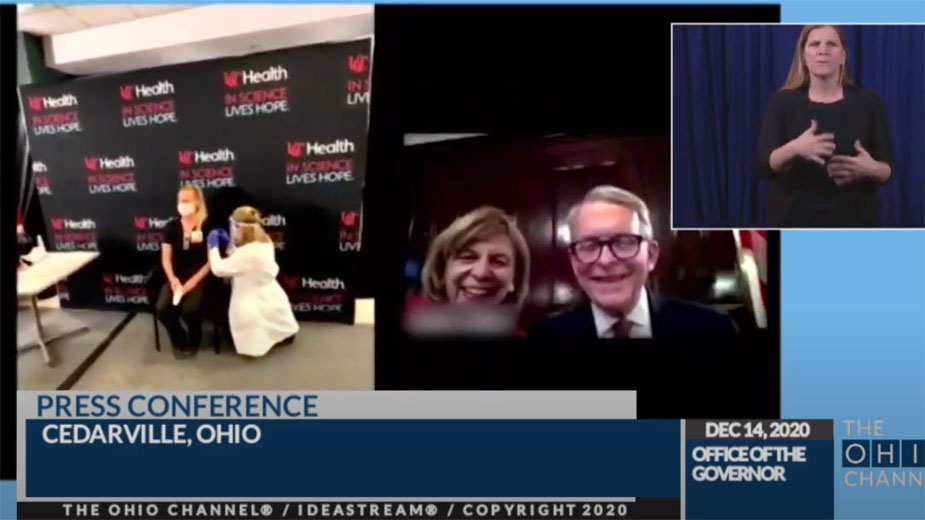DeWine Urges Ohioans to Continue Safety Measures as Vaccines Arrive
COLUMBUS, Ohio – With the first vaccines administered to frontline workers at Ohio hospitals – and more on the way in the coming weeks – the light at the end of the pandemic tunnel can be seen, but now isn’t the time to ease back on safety precautions, Gov. Mike DeWine said.
After watching the arrival of 975 Pfizer vaccines at Ohio State University’s Wexner Medical Center in the morning, the governor in the afternoon urged Ohioans to continue with safety measures.
“Until the vaccine is widely available for all ohioans to be vaccinated, we need to continue to use all available tools to prevent the spread of the virus,” he said. “The way I look at it, every day from here on, someone in Ohio will be getting vaccinated. … [Infection numbers are] still much too high. Even if it plateaus at this level, it’s too high and it’s not sustainable. On this great day of happiness and celebration, I want everyone to understand the realities of what we face.”
Currently, it’s not known if the vaccines – Moderna’s is expected to be approved by the Food and Drug Administration next week – protect those who’ve had the shot from spreading the coronavirus, said Dr. Bruce Vanderhoff, chief medical officer of the Ohio Department of Health.
“As of right now, what we know about the vaccine is that it’s incredibly effective at preventing the individual from receiving it. The CDC is still in the process with the FDA of studying how effective the vaccine is at protecting other people,” he said. “We’re very optimistic about the prospects for it just from how effective it is in protecting the individual.”
In addition to Wexner Medical Center, UC Health in Cincinnati also received a shipment of vaccines. The two hospitals are part of a 10-site group to receive the vaccines this week and, on Monday, administered them to a small group of frontline workers as a “dry run” before starting in earnest on Tuesday.
At Wexner, chief medical officer Dr. Andy Thomas said the vaccines will be given to emergency room and intensive care workers first.
“We don’t have enough vaccines in this first shipment to cover all employees in those areas, but the good news is that with the Moderna vaccine coming next week, we’ll be much closer to covering all our high-risk employees,” he said.
And in Cincinnati, Dr. Rick Lofgren, the president and CEO of UC Health, said the health-care system is following national guidelines for who gets vaccines this week.
“We really were focusing on the health-care workers in critical positions who have unavoidable exposure to infected patients and contaminated surfaces,” he said. “In our system, that’s about 1,900 individuals. We’re happy we could get it to these 975 individuals, but we’re really excited quickly following up with the Moderna vaccine to reach the rest of the people who have a particular risk so they can be there for patients going forward.”
In total, 9,750 Pfizer vaccines arrived at 10 Ohio hospitals Monday. Next week, 201,000 vaccines from Moderna will be shipped to the state’s 98 other hospitals and 108 health departments to vaccinate frontline workers. In addition Pfizer is set to deliver 123,000 doses to Walgreens and CVS next week to vaccinate residents in long-term care centers.
Initially, in “phase 1A” of the state’s vaccination plan, only residents of such centers and frontline workers – such as hospital staff and first responders – will receive the vaccines.
While most of the state’s nursing homes will be able to inoculate residents next week, DeWine said between five and 10 sites in Ohio will receive early shipments on Friday.
“Our team’s working out the details of when and where those vaccinations will happen. At this point, it’s a matter of scheduling. All nursing homes are a priority, but this scheduling is something the pharmaceutical companies will be doing,” DeWine said.
He also announced that the Ohio National Guard will partner with the Ohio Department of Health to help with distributing the vaccines to 350 “smaller communities” across the state.
Although the vaccine is available and expected to reach most of the general public by March or April, according to Dr. Anthony Fauci – a sentiment DeWine agreed with and hoped for during his press conference – state orders such as wearing a mask in public places and a curfew will remain in place until the governor’s team of advisers recommend otherwise.
“It depends on what the medical community tells us. It depends on what the best advice we have. … We’re going to wait,” DeWine said.
As frontline workers get their vaccinations against the virus, DeWine said there is still no official timeline on when the next stages of the state’s vaccination program will take place.
On Monday, Ohio Supreme Court Chief Justice Maureen O’Connor called for court workers at all levels to be part of the first phase, while the Ohio Restaurant Association urged to have restaurant staff added as well.
“There’s a compelling case to be made for both and there are compelling cases to be made for other groups of people,” DeWine said. “We’re still evaluating that, listening to guidance from the federal government, but for now we’re very focused on the 1A group and making sure we get that right. That’s not a small group. It’ll take a while to get through them.”
He added that decisions on which groups will receive vaccinations next “will be made upon saving lives and slowing the spread.” The state’s COVID-19 vaccination plan only called for “specific critical populations” to receive the shot.
Pictured: In footage shown during his Monday afternoon press conference, Gov. Mike DeWine and First Lady Fran DeWine watch the first frontline workers at UC Health get the COVID-19 vaccine.
Copyright 2024 The Business Journal, Youngstown, Ohio.



